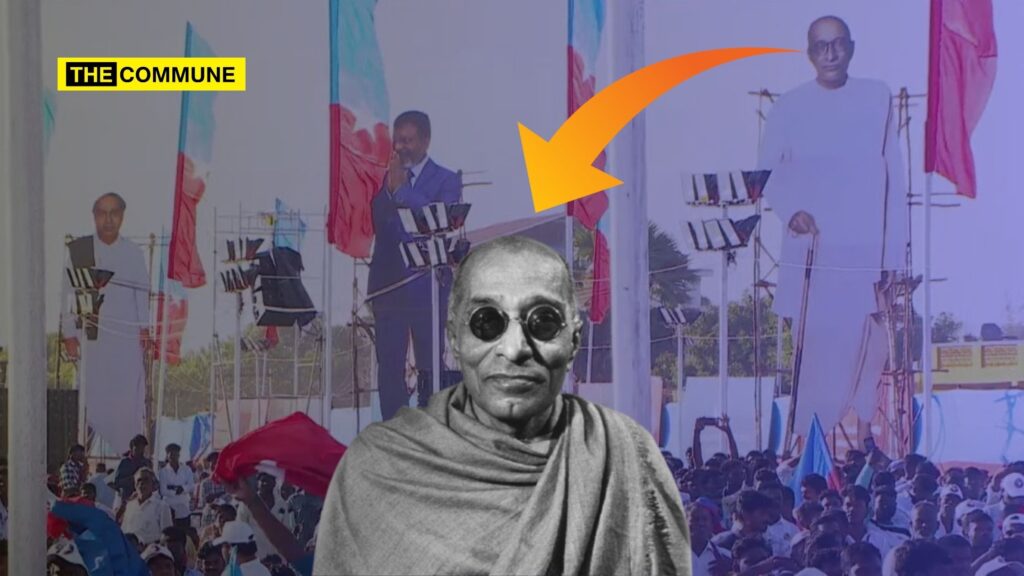Freedom fighter and former Chief Minister of Tamil Nadu Rajagoplachari’s cutouts at the VCK convention shocked a few Dravidianists. However, it is not out of the blue that Thol. Thirumavalavan, or his strategist Adhav Arjuna, placed his cutout with other leaders like Annadurai. Let’s look at what Rajaji has done for Tamil Nadu, particularly regarding social justice and alcohol prohibition.
Pioneer Of Prohibition
Rajaji implemented alcohol prohibition and continued that policy throughout his life. He held the “umbrella” for alcohol abolition.
In 1929, Rajaji started a unique magazine dedicated solely to promoting the cause of alcohol prohibition and achieved remarkable success, with circulation surpassing 4,000 within just ten months. It was edited and published by Rajaji himself, from his ashram in Tiruchengode. Assisting him in this effort was ‘Kalki’ R. Krishnamurthy, who would later become a well-known writer and journalist.
The magazine’s cover featured striking images illustrating the harmful effects of alcohol. Additionally, Rajagopalachari wrote a song inspired by poet Subramania Bharathi’s ‘Jayaperikai Kottada’. The publication included two compelling stories on alcoholism, along with articles, brief notes, cartoons, and even a Q&A section on the topic.
After the Congress came to power in the provincial elections, it took just two months to pass the Tamil Nadu Prohibition Act, 1937, which imposed a ban on alcohol. The swift passage of the act in the Assembly surprised many, with newspapers commenting on the opposition’s lack of effectiveness.
Prohibition was initially implemented on a trial basis in Salem, Rajaji’s home district, and gradually expanded to other areas. Strict enforcement measures were introduced, leading to the closure of liquor shops and a ban on liquor advertisements.
To offset the loss in revenue from the alcohol ban, Rajaji introduced taxes targeting the wealthy, shifting government revenue generation from rural areas to urban centers. His government also kept a close watch on bootleggers involved in brewing or smuggling liquor. The police were given broad powers to enforce the ban, and officers with known drinking habits were transferred out of the district. In one instance, police pursued and fatally shot a bootlegger who crossed into Mysore, sparking a lengthy legal battle. Rajaji staunchly defended the Madras police throughout the case.
Governor Lord Erskine reported to the King that prohibition had been more successful than anticipated, and the King’s secretary responded, noting the King’s particular interest in the policy and praising Rajaji’s strong character. However, the onset of World War II and India’s forced participation without consent led the Congress party to resign from provincial governments in protest. Despite this, prohibition remained in place until 1971, when the DMK government under Karunanidhi lifted the ban.
True Champion Of Social Justice
Under Rajaji’s governance, it was Vaidyanatha Iyer, Rajaji’s “Commander-in-Chief”, who led the temple entry movement under his direction. In September 1939, he successfully had the bill for temple entry passed in the Legislative Assembly, which then became law. Following the landmark entry into the Meenakshi Amman Temple, other temples, including Azhagar, Thiruparankuntram, Thiruvarangam, Pazhani, and Srivilliputhoor, also allowed temple entry by December 1939. Rajaji strongly supported Iyer in ensuring the success of the temple entry movement.
In 1937, Rajaji who became the Chief Minister of Madras Province for the first time, made VI Muniyasamipillai, who belonged to the Scheduled Community, the Minister of Agriculture and Rural Development.
Also, Mr. Sivashanmukampillai, who belongs to the Scheduled Caste community, became in charge of Madras as the Mayor in 1938. Rajaji made the same Sivashanmukampillai the first speaker of Tamil Nadu after independence.
Rajaji made Rukmini Lakshmipathi as the first woman to be elected to the Madras Legislature and the first to serve as a minister in the Madras Presidency. She was the first woman member of the Legislative Assembly and the woman who was convicted by the British government in the Salt Satyagraha.
It was Rajaji who ended the zamindari system which helped the landless peasants to get agricultural land.
Fighting For “Madras”
It was Rajaji who brought Madras to Tamil Nadu instead of it being a part of Andhra Pradesh! Despite the Bifurcation Committee’s decision to give Madras to Andhra Pradesh, Rajaji was adamant that Andhra would not have Madras for a single day, and he would not allow that!
Viduthalai Chiruthaigal Katchi members seem to have risen beyond petty grudges and honoured Rajaji.
VCK மாநாட்டில் ராஜாஜியின் கட் அவுட்டுகள் இருந்தது சிலருக்கு அதிர்ச்சியை அளிக்கிறதாம்…
ராஜாஜி தமிழகத்துக்கும் சமூக நீதிக்கும் என்ன செய்தார் என்பதைப் பற்றி சில தகவல்களைப் பகிர்ந்து, ஏற்கனவே 'அதிர்ச்சி'யில் உள்ளபவர்களுக்கு இன்னும் கொஞ்சம் அதிர்ச்சி கொடுப்போம் வாங்க… 😅👇… pic.twitter.com/2GxkLmVRc1
— Ko Sesha (@KoSesha) October 3, 2024
Subscribe to our Telegram, WhatsApp, and Instagram channels and get the best stories of the day delivered to you personally.

